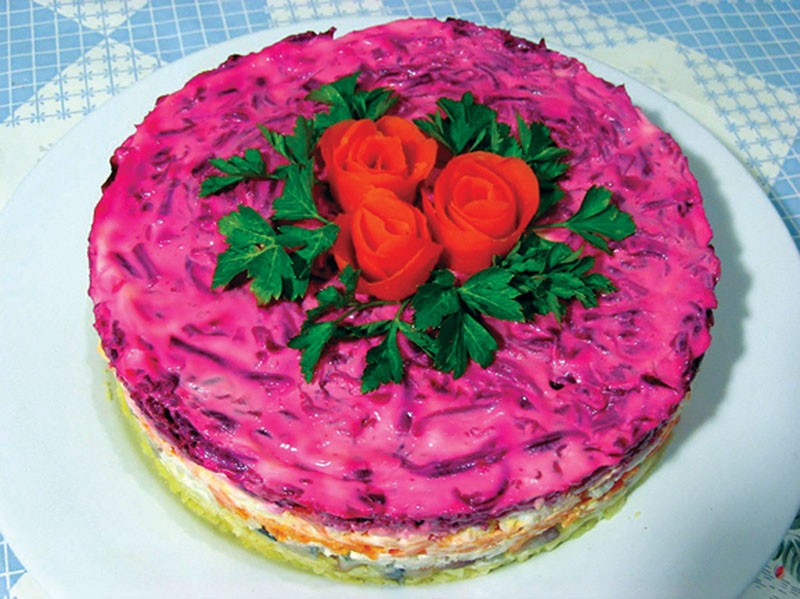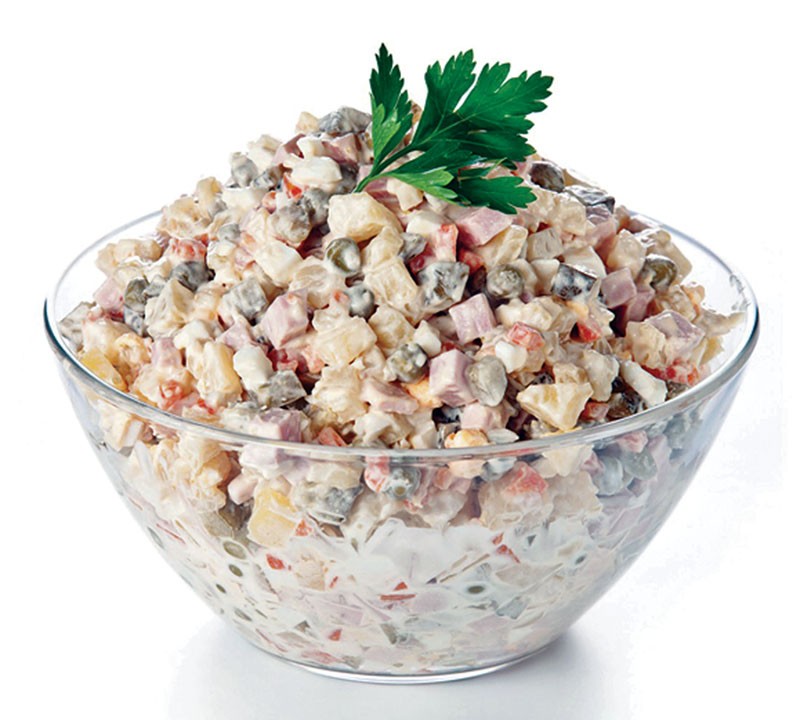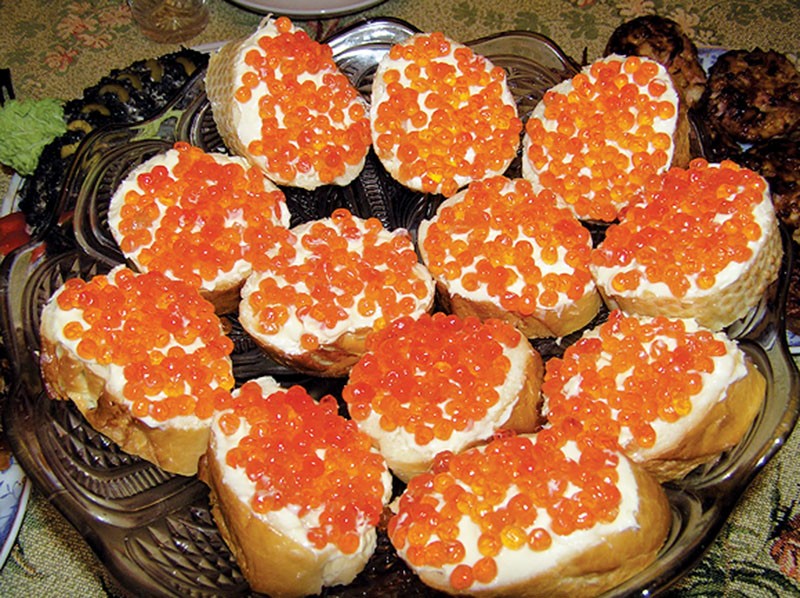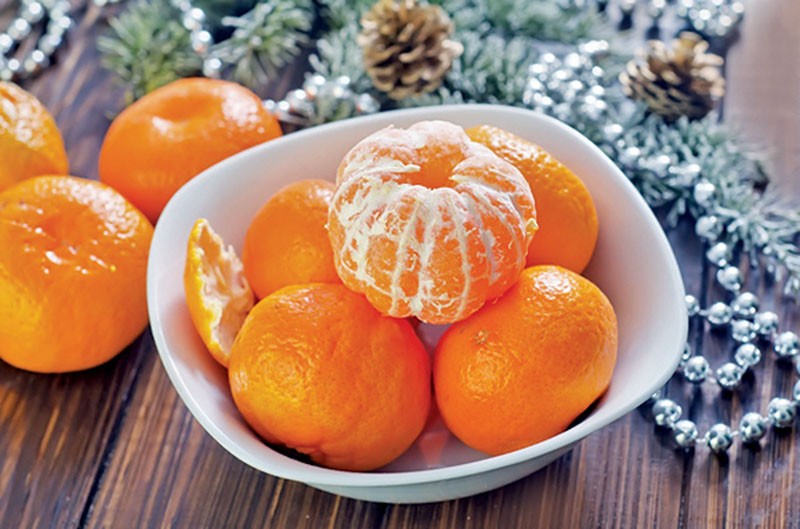Finding one’s way around a Ukrainian holiday feast can be a tough challenge. Which food is traditional Ukrainian and which is Soviet classics? How come that there is no roast goose but there is a meat jelly? How many mayonnaise salads are too many? What is the deal with red caviar?
The questions are piling up like layers of a dressed herring salad.
Christmas vs. New Year
Ukrainians celebrate both Christmas and New Year with lavish dinners. But while Christmas dinner focuses on traditional Ukrainian food, the New Year feast is dominated by the Soviet dishes – a tribute to the era when the New Year started dominating over Christmas.
“Soviet New Year and Ukrainian Orthodox Christmas are antagonistic holidays,” says Dmytro Borysov, the owner of Borysov’s Gastrofamily restaurants chain. “The first one is a holiday of nostalgic, tasty and unhealthy food. Christmas also offers a lot of food, but all the dishes must be fast.”
Unlike the westerners, most Ukrainians celebrate Christmas after the New Year. The Orthodox church has been celebrating Christmas on Jan. 7 since 1918, when the authorities moved towards the newer Gregorian calendar, while the church decided to stick to the old Julian calendar, creating a two-week gap.
Cooking for New Year
Borysov described the traditional Soviet New Year celebration as the triumph of ‘unhealthy, greasy, but extremely tasty’ food.
“Shuba and Olivie salads, kholodets, tangerines and cheap semi-sweet champagne is what the doctor ordered,” said Borysov.
Here are five dishes that one would definitely find on the table of any Ukrainian family on the New Year Eve.
Kholodets
Kholodets or meat jelly is a cold jelly bouillon with meat, carrots, and bones. The dish is also popular in French cuisine. The jelly can also be made from a fish soup.
Borysov thinks that kholodets found so many admirers in Ukraine because it has a savory taste, known as umami.
“It is a dish for true meat or fish lovers. Just imagine sturgeon in jelly with the orange stars of carrots, beautifully served. What can be better?” the restaurateur says.
Ingredients: 2 lb pork or beef with bones or chicken legs, 1 lb boneless meat (of any kind), water, an onion, 2 teaspoons of salt, 1 teaspoon of pepper, 2 laurel leafs, gelatin.
How to cook: Put all the ingredients into a large pot, add enough water to cover them, bring water to a boil, skim off the foam, and simmer for three hours. Then take all the meat out of the pot, separate the meat from the bones, chop the meat and lay it out in a soup bowl. Strain the remaining liquid, add gelatin. Pour the liquid into the dish and put the dish into the fridge for a night. Serve kholodets with mustard or horseradish sauce.

Shuba Salad
Shuba salad, also known as dressed herring or herring under a fur coat, has become a popular New Year dish in the 1970s. Borysov describes shuba as “an ideal combination of salty herring, waiting for you on a potato pillow with a slightly sour taste of apples, covered with mayonnaise”.
There is a vegetarian version of shuba, called “the sea under a fur coat,” where the herring is replaced with luminaries and eggs with avocado.
Ingredients: herring fillet (350 grams), one onion, 3 boiled spuds, 3 boiled carrots, 2 boiled red beets, 3 hard-boiled eggs, mayonnaise.
How to cook: Chop all the ingredients, except the red beets (it must be fine grated) and put them in layers into the dish, covering every layer with mayonnaise. The order of layers is as following: herring, onion, potato, carrots, eggs, red beets.

Olivier Salad
Olivier is arguably the most popular salad in the post-Soviet countries. It is also famous as Russian salad or salad “a la Russe” in the West. The legend says that the salad was invented in Russia in the 19th century by French chef Lucien Olivier, the owner of Hermitage restaurant in Moscow. The original recipe includes some high-end ingredients such as capers, quail, crab and mayonnaise made from olive oil. But in the 20th century the recipe changed to fit the scarce selection of food at the Soviet stores. Capers were replaced with green peas, while quail and crabs gave way to chicken and cheap bologna.
According to Borysov, Olivier has become so popular partly because it has an ideal combination of fats and carbohydrates for a winter meal.
Ingredients: 4 boiled spuds, 2-3 boiled carrots, 500 grams of chicken fillet, 4 hard-boiled eggs, 250-300 grams of pickles, 500 grams of canned peas, herbs and mayonnaise or sour cream.
How to cook: Chop all the ingredients except for peas, put all the ingredients in one bowl and mix them with mayonnaise. Leave it for several hours.

Tartines with caviar
Salmon caviar tartines are appetizers on the New Year table. Soviet tradition prescribes to put butter and a teaspoon of caviar on slices of white baguette. Serve the caviar tartines on a huge dish, decorated with parsley.
Ingredients: a can of salmon caviar (130 grams), butter (100 grams), white baguette, parsley for decoration.

Tangerines for desert
The smell of tangerines is a symbol of winter holidays in Ukraine – a yet another heritage from the Soviet times. The tangerines popularity during winter could be explained by the USSR economy, where all the produced goods were divided between the member republics. Every December, the Caucasian republics had a huge harvest of tangerines, oranges and date-plums.
“So there was supposedly an order to sell the harvest and for that to make the tangerines ‘the healthy fruit number one’,” Borysov says.
Cooking for Christmas
The Orthodox Christmas tradition orders to serve 12 lenten dishes in honor of the 12 apostles. The Christmas Eve dinner marks the last day of a fast that starts 40 days before Christmas.
Fried fish
One can use any kind of low-fat fish for this dish. The only condition is not to use eggs for planking.
Ingredients: Any fish, a little oil and flour.
Borsch
Many Ukrainians can’t imagine a Christmas dinner without this most famous dish of Ukrainian cuisine. But a Christmas version should have mushrooms instead of meat.
Ingredients: water (3 liters), 3-4 red beets, 3-4 spuds, 2 carrots, one onion, pepper, 2 laurel leafs, salt, 1-2 spoons of lemon juice and mushroom broth.
How to cook: Clean and dice all the vegetables, put them in a large pot filled with water, cook for 30 minutes, removing the foam all the time. Add spices and boiled grated red beets and leave for 20 minutes.
Uzvar
Uzvar is a traditional sweet Ukrainian beverage made from dried fruits, berries and honey. Uzvar symbolizes fertility because of the variety of ingredients and diversity of taste. Having uzvar on the Christmas table is believed to bring wealth and happiness in the new year and make life sweeter.
Ingredients: Dried apples (200 grams), dried pears (300 grams), prunes (200 grams), raisins (100 grams), honey (250grams), and water (2 liters).
How to cook: Cover dried fruits with cold water for 10 minutes. Add the pears into the boiling water and cook for 20 minutes. Then add the apples, prunes, and raisins. Cook for 15 minutes more. Add the honey. Bring to the boil and take the pot off the cooker. Serve cooled.

Kutia
Kutia, a ritual dish, is a symbol of the Orthodox Christmas feast in Ukraine. It is porridge made of whole wheat, poppy, nuts, dried fruit, and honey. Eating kutia is a ritual that, according to Ukrainian tradition, unites the living and the dead. After the Christmas dinner, kutia should be left on the table for a night so that the spirits of their dead ancestors could also enjoy the family meal.
Borysov said the secret of tasty kutia is in the poppy.
“Put as much poppy as you can but before that cook the poppy right – powder it “to the poppy milk” until you get some kind of a cooking opium,” Borysov said.
Ingredients: a cup of wheat grains, dried fruits (100-150 grams), poppy (100-150 grams), walnuts (100 grams), dried fruit and 2-3 tablespoons of honey.
How to cook: Boil wheat on a slow fire for an hour, then add the powdered poppy and fruits, nuts and honey and mix it with the cooked porridge.

Varenyky with cabbage
Varenyky is one of the 12 obligatory fast dishes on the Christmas table. This traditional Ukrainian dish is also called pierogi in the western regions. Varenyky is a popular everyday dish and can be made with any salty or sweet stuffing. But Christmas varenyky must be fast and filled with cabbage or mashed potatoes.
Ingredients: water (250 ml), bread-stuffs (650 grams), sour cabbage (1 kilogram), fresh cabbage (500 grams), oil, 2 onions, 1 soupspoon of salt.
How to cook: Mix the dough and leave it for 20-30 minutes. Then roll out the dough and crop circles from it using a cup. Fry the chopped onion and boil the sour and fresh cabbage, mix them up and stew for 10 minutes in the frying pan. Put a spoonful of stewed stuffing into each circle and connect its borders. Boil varenyky for 10 minutes.n
